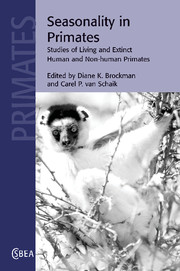Book contents
- Frontmatter
- Contents
- List of contributors
- Preface
- Part I Introduction
- Part II Seasonal habitats
- Part III Seasonality and behavioral ecology
- 3 The influence of seasonality on primate diet and ranging
- 4 Seasonality in predation risk: varying activity periods in lemurs and other primates
- 5 Physiological adaptations to seasonality in nocturnal primates
- 6 Seasonality and long-term change in a savanna environment
- 7 Day length seasonality and the thermal environment
- 8 Seasonality in hunting by non-human primates
- 9 Human hunting seasonality
- Part IV Seasonality, reproduction, and social organization
- Part V Seasonality and community ecology
- Part VI Seasonality and human evolution
- Index
- References
9 - Human hunting seasonality
Published online by Cambridge University Press: 10 August 2009
- Frontmatter
- Contents
- List of contributors
- Preface
- Part I Introduction
- Part II Seasonal habitats
- Part III Seasonality and behavioral ecology
- 3 The influence of seasonality on primate diet and ranging
- 4 Seasonality in predation risk: varying activity periods in lemurs and other primates
- 5 Physiological adaptations to seasonality in nocturnal primates
- 6 Seasonality and long-term change in a savanna environment
- 7 Day length seasonality and the thermal environment
- 8 Seasonality in hunting by non-human primates
- 9 Human hunting seasonality
- Part IV Seasonality, reproduction, and social organization
- Part V Seasonality and community ecology
- Part VI Seasonality and human evolution
- Index
- References
Summary
Introduction
Human hunting strategies, like those of many non-human primates, vary seasonally with fluctuations in prey abundance, encounter rates, and profitability (Winterhalder 1981; Smith 1991). Temporality in resource supply has profound social effects as well, and some of the earliest studies of hunter–gatherers emphasized the impact of seasonality on settlement size, mobility, general economic organization, and even property rights, religion, family structure, and the sexual division of labor (Mauss & Beuchat 1906; Thomson 1936). For Mauss and Beuchat (1906), seasonality meant temperature: they suggested that Inuit families were organized very differently in the summer than in the winter as a result of the nature of changes in foraging opportunities. For Thomson (1936), seasonality meant rainfall, commenting that the effect of distinct wet and dry seasons in northern Australia might lead one to think that they were observing two different “tribes” of people. Anthropological interest in seasonality and its effects on human social organization has waned since then, frustrated by an inability to find correlations between seasonality and human behavior. Our goal in this chapter is to explore the utility of two approaches to understanding the relationship between seasonality and social behavior. One attempts to use comparative ecological data across groups to explain differences in aspects of social and economic behavior such as mobility and land tenure decisions; the other examines how different individuals within a group may respond differently to resource seasonality.
- Type
- Chapter
- Information
- Seasonality in PrimatesStudies of Living and Extinct Human and Non-Human Primates, pp. 243 - 266Publisher: Cambridge University PressPrint publication year: 2005
References
- 15
- Cited by



